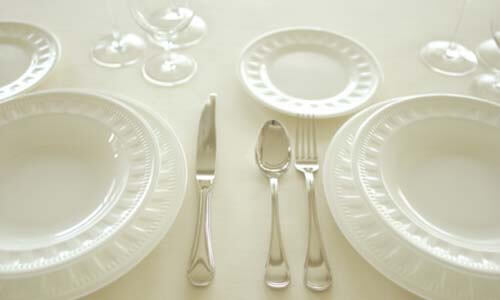Preparing Tea
Tea and Tea Etiquette
A few simple steps make excellent tea.
Draw cold fresh water from a tap
Fresh cold water contains more oxygen than hot tap water or water previously boiled and is vital in capturing the flavor of tea. Bottled spring water is also an excellent source of fresh water, reportedly used by the Queen of England when she travels.
Bring fresh cold water to a rolling boil
Depending on the altitude, water boils at a temperature of approximately 212°F (100°C). By comparison, water taken "instantly hot" from a tap varies from 185 to 195°F (85 to 91°C). Be careful not to overboil the water: the longer water boils, the less oxygen it contains. Furthermore, do not allow boiled water to cool before infusion; otherwise, the water goes flat and cannot draw full flavor from the leaves.
Why not boil the water and the tea leaves together? Because tannin is insoluble in water, and when water is boiled with tea leaves, the tannic acid increases and makes the brew taste bitter.
Preheat the teapot
To sustain the temperature of boiled water when it is poured into the teapot, first fill the teapot with hot tap water and swish it around. Empty the water, take the teapot to the kettle, and fill it with boiling water.
Pour boiling water over tea leaves
The action causes the leaves to rise and open up for full infusion and promotes tea with optimum flavor and aroma.
Just before serving, stir the leaves
To distribute the essential oils evenly, balance the strength, and enhance the flavor and aroma of tea, just before serving stir the leaves. But before pouring tea into a cup, wait a few seconds for the leaves to settle to the bottom of the teapot.
Pour tea through a strainer
To keep tea leaves from entering the teacup, pour the brew through a strainer.
How much tea should you use? A pound of tea produces approximately 200 cups of tea. To make a pot of tea from black tea or oolong, depending on strength, use one rounded or heaping teaspoon of tea per 6 ounces of water, plus one for the pot. To make a pot of green tea, use two rounded teaspoons of tea per cup, plus one for the pot. To brew tea from tea bags, use one bag per cup.
The strength of tea is determined by the time allotted for infusion. Twisted tea leaves take longer to infuse than flat leaves. Small leaves infuse quicker than coarse leaves. And tea is steeped by the clock and not by the color. In general, the best infusion time is between 3 and 5 minutes. Whole-leaf black tea steeps in 4 to 5 minutes; broken-leaf black tea steeps in 3 minutes; large-leaf oolong steeps in 7 minutes; green tea steeps in 1 to 3 minutes; and tea bags steep in 30 seconds. If after infusion the flavor of tea is too strong, dilute the strength with a little hot water. Here are some infusion tips.


